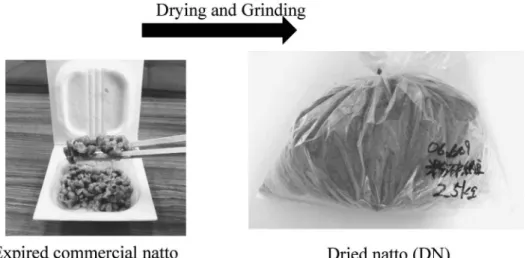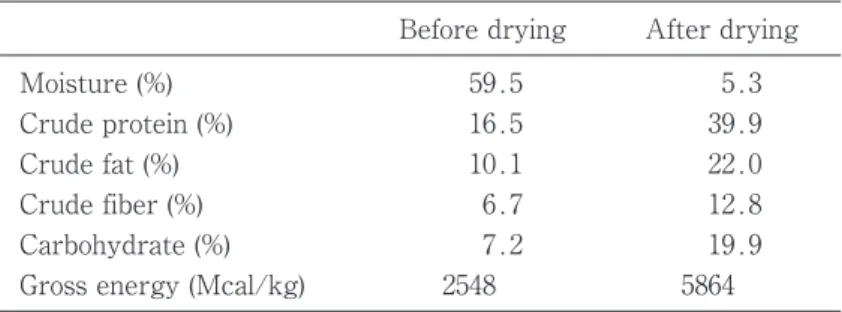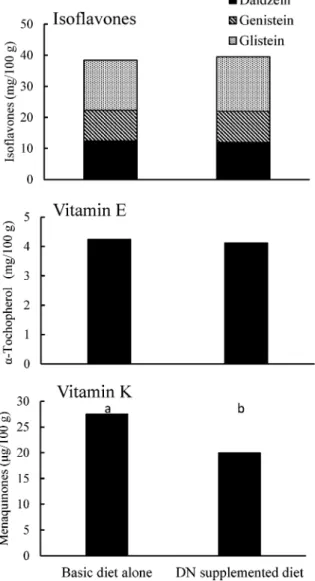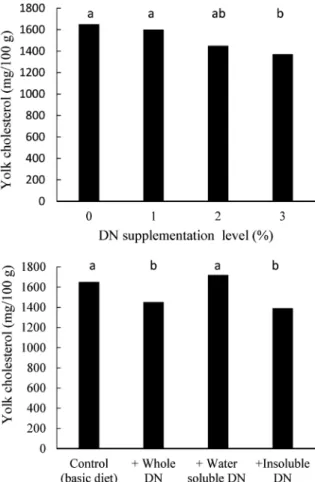Reus e of Expi r ed N
at t o ( Fer m
ent ed Soybeans ) as
an Ani m
al Feed
著者
M
I YAG
U
CH
I Yuj i , N
I SH
I N
O
Kaget om
o, O
G
AW
A
Yas uki
j our nal or
publ i c at i on t i t l e
J our nal of D
evel opm
ent s i n Sus t ai nabl e
Agr i c ul t ur e
vol um
e
11
num
ber
1
page r ange
23- 30
year
2016- 08- 04
U
RL
ht t p: / / hdl . handl e. net / 2241/ 00150263
Reuse of Expired Natto (Fermented Soybeans) as an Animal Feed
Yuji Miyaguchi
1*, Kagetomo Nishino
1, 2and Yasuki Ogawa
11College of Agriculture, Ibaraki University, Chuo 3-21-1, Ami-machi, Ibaraki, 300-0393, Japan 2Present affiliation: Ibaraki Prefectural Livestock Research Center,
Touno 3700, Hitachiomiya, Ibaraki, 319-2224, Japan
Japan’s low rate of food self-sufficiency̶particularly in terms of its livestock industry̶is a cause forconcern.
In addition, Japan annually generates food waste equivalent to 20% of the food consumed. Many producers of natto̶a fermented soybean product with high nutritional benefits̶face difficulties in disposing of expired products
or surplus stock. To address these issues of food self-sufficiency and food waste disposal, we have been exploring the possibility of adapting unused natto as a feed for swine and poultry. Here, we prepared dried natto (DN) from com-mercial expired natto and investigated its suitability as a feed supplement for layer chickens.
In preliminary studies, we confirmed that feed supplemented with 3% DN had adequate palatability for feeding to chickens. This study revealed that the egg productivity and feed conversion efficiency of chickens that received fed the diet with 3% DN did not differ significantly from those of a control group. In addition, DN supplementation did not affect various measures of egg quality, including shell strength and freshness, or alter the concentrations of isoflavones and vitamin E in eggs. However, yolk concentrations of vitamin K and cholesterol decreased after sup-plementation with DN; the water-insoluble fraction of DN caused the decrease in cholesterol. These results suggest that expired natto can be used as a feed supplement with decent effects on egg quality. Further study is needed to evaluate the reusability of various food wastes to build a worldwide food-recycling society.
Key words: cholesterol, feed, fermented soybean, layer chicken, natto
───────────────────────
Introduction
Since the beginning of the high-growth period, Japan has imported much of its food. Therefore, Japan’s food self-sufficiency rate remains at approximately 40%, and its livestock feed self-sufficiency fell dra-matically from 47% in 1965 to 17% in 2005 (Ministry of Agriculture, Forestry and Fisheries, 2013). The rate of self-sufficiency in concentrated animal feeds is currently approximately 12% overall, with rates of 11% forwheat, 0% forcorn, and 6% forsoybeans in 2009 (Nakata, 2011). Additionally, there is an indi-catorof a domestic food supply, which is termed as “food miles”. This is computed by multiplying the quantity of food transported (tonnes) by the
transporta-tion distance (km). Japan’s food miles are by far the highest in the world: the total food miles for soybeans was 20.5 billion ton・km in 1960 but had increased to
67.3 billion ton・km by 2010 (Nakata, 2011).
Recently, lifestyle changes based on large-scale production and consumption have led to the sharp in-crease in food waste. Food waste is created at various stages of production. For example, soybean curd and breadcrumbs are regarded as food waste in food manu-facturing. Surplus stock is accumulated during whole-sale storage. Expired and unsold food products, such as boxed lunches and deli items, are accumulated as food waste by retail stores. Cooked waste and leftover foods are accumulated by restaurants. Japanese gov-ernment survey say as follow. Approximately 18
mil-Received: September 9, 2015, Accepted: February 29, 2016
* Corresponding author: College of Agriculture, Ibaraki University, Chuo 3-21-1, Ami-machi, Ibaraki, 300-0393, Japan. Tel:+81-29-888-8580, Fax:+81-29-888-8525
lion tons of food waste̶an amount equivalent to 20%
of all foods consumed̶is generated annually in Japan.
Food waste in the form of surplus stock, expired foods, and leftovers (so-called “food loss”) accounts for 5 to 8 million tonnes of this figure each year̶an amount nearly equal to the total annual rice yield in Japan (8.5 million tonnes in 2012). To reduce and recycle vari-ous food wastes, Japan established a food recycling law in 2001, and target levels of 10% food waste re-duction by August 2015 were established for 31 indus-try sectors. Currently, the recycling rate of food waste from food processing is relatively high (38%), but that from restaurants is very low (4%) (Ministry of the En-vironment Japan, 2013).
Preparation of livestock feed from food waste is considered superior to composting of the waste, be-cause selling price of livestock feed is higher than that of compost. To increase the reuse rate of food wastes, however, candidate feedstuffs must be selected care-fully. Therefore, information regarding food waste̶
including its ingredients, forage quality, and safety̶is
needed. If the food waste contains useful quantities of functional ingredients, the feed prepared from it can be marketed as a high value‒added feed to increase the
additional value of livestock products.
To create a food-recycling system, each local re-source should be used effectively in terms of food miles. We have been studying the effective use of crop and food-processing wastes in our local area of Ibaraki Prefecture, North Kanto, Japan. This region is known forhoshi-imo (dried sweet potato) and natto (fermented soybeans). Natto is produced by using the
Gram-positive spore-forming bacterium Bacillus sub
-tilisvar.natto(B.natto) to ferment soybeans (Ashiuchi
et al., 1998). The nutritional benefits of soybeans in-clude theirabundance of lysine (in which plant pro-teins typically are poor), and high functional ingre-dients such as isoflavones and nattokinase. In addi-tion, natto is rich in fiber, carbohydrates, vitamins, and minerals.
To translate unused natto as a feedstuff, we have been studying its effect on the productivity and quality of chicken meat (Fujiwaraet al., 2008). In this study, we investigated on the reusability of natto, obtained as surplus stock, as a supplement for livestock feed and describe the effects of dried natto on egg production and quality.
Materials and Methods
Preparation of dried natto
Commercial natto 7 days past its expiration date was obtained from Takano Food Co. Ltd. (Ibaraki, Japan). The natto was dried in a drying oven at 60℃for60 h,
then ground into 1-mm particles by using a feed mill (Figure 1). The resulting dried natto (DN) was stored at 4℃until use. It was confirmed using nutrient agar
media that viable bacteria in DN contained more than 1
×109
cfu/g equivalent to that in natto before drying. To fractionate DN into its water-soluble and -insoluble fractions, DN was dispersed in 10 volumes of distilled waterfor24 h. Afterfiltration overfilterpaper(No. 2, ADVANTEC, Tokyo, Japan), the filtrate was freeze-dried and stored in a refrigerator as the water-soluble-fraction of DN. The residue was treated with acetone,
J. Dev. Sus. Agr. 11 (1) 24
afterwhich the acetone powderwas recovered as the water-insoluble fraction of DN.
Nutritional composition analysis of natto
The chemical composition of untreated natto and DN, including proportions of moisture, crude protein, crude fat, crude fiber, and crude ash, was determined (AOAC, 2012). Briefly, moisture content was measured by using the oven-drying method at 135℃. Crude pro-tein was determined by the Kjeldahl method of nitro-gen analysis, and crude fat was determined by mea-suring the ethyl ether extract content using the Soxhlet extraction method. Crude ash content was measured as the weight of the minerals and other inorganic mat-terremaining afterincineration at 550℃. Carbohy-drate content was calculated as the nitrogen-free ex-tract as follows: 100%−(crude protein+crude fat+
crude ash+crude fiber). The gross energy of natto
was determined the total amount of energy that the natto contained.
Animals and test conditions forfeeding
To investigate egg productivity and quality, 23-week-old layerchickens (Rhode Island Red) were housed in groups of 20 and were randomly assigned to receive a DN-unsupplemented diet (basic diet alone, Layer17S; Chubu Shiryo Co. Ltd., Aichi, Japan) ora basic diet with DN supplementation (DN-supplemented diet) for 3 months. To confirm the yolk cholesterol-lowering effect on the other chicken breed, groups (n =16 each) of 27-week-old layerchickens (White
Leg-horn) were fed a basic diet (Pureiya-tu; Toyohashi Shiryo Co. Ltd., Aichi) with or without natto supple-mentation for 1 month. During the experiments, the chickens had unrestricted access to feed and water. Daily egg production in each group was calculated as the total numberof eggs collected divided by the total numberof layerchickens. The feed conversion rate in each group was calculated as the weight of feed con-sumption divided by the weight of eggs produced. All procedures were approved by the guidelines of the Ibaraki University Animal Care and Use Committee.
Evaluation of egg quality
Egg weight was assessed as a basic property of eggs in the shell. Eggshell strength was tested by using an eggshell force gauge (Model 2; Robotmation, Tokyo). Egg freshness was reported in Haugh units and deter-mined through the measurement of albumen height and
egg weight by using an egg multi-tester(EMC500C; Robotmation). Yolk colorwas evaluated according to the numbers on a Roche yolk color fan. Isoflavones in yolk were extracted by using 0.5 M hydrochloric acid and ethanol (Collison, 2008). α-Tocopherol in yolk
was extracted as vitamin E by using a hexane‒ethyl acetate mixture, followed by saponification with alka-line pyrogallol (Chase et al., 1999). Menaquinone was extracted from yolk by using n-hexane (Kamaoet al., 2005). The concentrations of these compounds were determined through chromatographic separation by using an HPLC system (Chromaster; Hitachi High-technologies, Tokyo, Japan). Cholesterol in yolk was extracted with isopropanol after saponification with alkaline isopropanol and measured by using an enzy-matic colorimetric assay kit (F-kit Cholesterol; Roche Diagnostics, Basel, Switzerland) according to the manufacturer’s instructions.
Statistics
All data were subjected to 1-way ANOVA test using Microsoft Excel 2010.
Results
Nutritional profile of DN and its effect on egg pro-duction and quality
In terms of chemical composition, the moisture content of DN was only 5%, which was at most one-tenth that of untreated natto (Table 1). In addition, the crude protein, crude fat, crude fiber, and carbohydrate contents of DN were highly enriched by the drying of untreated natto. The gross energy of DN was approxi-mately twice that of untreated natto. Dietary supple-mentation with 3% DN led to no significant differences in egg production or feed conversion rate compared with those of Rhode Island Red layers fed a DN-un-supplemented diet (Table 2). Egg weight, eggshell strength, and yolk color, and egg freshness of the DN-supplemented group were not significantly different from those of the control group.
Effect of feed supplementation with dried natto on various components in egg yolk
of vitamin K and cholesterol (Figure 3).
To confirm the effect of DN on yolk cholesterol, we repeated the feeding test by using a different species of layer (White Leghorn) and several levels of DN sup-plementation (Figure 4). Yolk cholesterol decreased dose-dependently with DN supplementation, with a significant difference in yolk cholesterol concentration between 0% (basic diet alone) and 3% DN supplemen-tation. Furthermore, supplementation with the water-insoluble DN fraction caused the same decrease in yolk cholesterol concentration as did supplementation with total DN.
Discussion
Natto is a Japanese food with health benefits. On the assumption that feeding surplus fermented soybean stock would incurno obvious health problems in layer chickens, we investigated the effect of feed supple-mentation with expired natto on egg productivity and
quality. We found that DN supplementation did not alter egg production by layers or the egg characteristics of shell strength, yolk color, and freshness. Thus, sup-plementation with 3% DN for3 months did not in-crease these measures of egg quality in this study, sug-gesting that increased amounts of DN or prolonged feeding periods (or both) are required to achieve these effects.
It is known that some dietary components are trans-ferred directly into meat and eggs. We found here that supplementation with DN did not alterisoflavone (daizein, genistein, and glycitein) orvitamin E con-centrations in yolk but significantly reduced yolk vita-min K levels. In contrast to these findings, isoflavones (Suzuki and Okamoto, 1997),α-tocopherol (Grobaset
al., 2002), and menaquinone-7 (Saitoh et al., 2001) reportedly are readily transferred into yolk. In ad-dition, the observation that DN supplementation re-duced vitamin K levels suggests that the vitamin K
J. Dev. Sus. Agr. 11 (1) 26
5.3 Moisture (%)
The tested material was commercial natto that was 7 days past its expiration date.
Gross energy (Mcal/kg)
Table 1. Nutritional composition of natto before and after drying at 60℃for 60 h
19.9 7.2 Carbohydrate (%) After drying 5864 Before drying
Crude fat (%)
12.8 6.7
Crude fiber (%)
39.9 16.5
Crude protein (%)
22.0 10.1
59.5
2548
Egg production (%)
For 3 months, layer chickens received a control diet or a diet supplemented with 3% DN. Test parameters were assessed just before and immediately after the 3-month feeding period.
Egg freshness
Table 2. Egg production and egg-quality measures with and without dietary supplemen-tation with dried natto (DN)
After
12.0 Yolk color
Before
Without DN
Egg weight (g)
83.9 12.9 12.4 3.22 3.38 52.8 3.29
Eggshell strength (kg/cm2)
54.3 2.17 2.00 85.7 90.0 After Before With DN 2.30 Feed conversion rate (kg/kg egg)
concentration in yolk is regulated by homeostatic control in spite of the excessive intake of natto, which is rich in vitamin K. Further study of the transfer of these components from natto to egg yolk is needed. In addition, DN supplementation reduced the cholesterol level in egg yolk; the same effect was achieved by using the water-insoluble fraction of DN, which included the fat, protein, and fiber derived from soybean or B.natto and theirmetabolic products. When dietary cholesterol intake increases, plasma
cho-lesterol levels rise, and the risk of cardiovascular dis-eases and atherosclerosis incrdis-eases (Connor and Connor, 2002). For this reason, low-cholesterol foods attract higherconsumerdemand than do conventional products.
Some beneficial bacteria (so-called “probiotics”), when administered in sufficient amounts, confer health benefits on the host (FAO/WHO, 2001). Part of the recent interest in probiotics may reflect their improve-ment of lipid metabolism (Endoet al., 1999; Santoso
et al., 1995). In fact, the feeding of probiotics to chickens is known to loweryolk cholesterol levels (Mohan et al., 1995; Abdulrahim et al., 1996; Haddadimet al., 1996), and feedingB.subtiliscultures to chickens decreases yolk cholesterol content (Xu et al., 2006). According to theory, probiotics facilitate the digestion of cholesterol by enteric microorgan-isms. In this regard, Gilliland et al. (1985) reported that the ingestion of cholesterol by microorganisms decreased cholesterol levels in the feces. Fukushima and Nakano (1995) suggested that ingestion of pro-biotics leads to the inhibition of HMG-CoA reductase,
Fig. 2. Effects of dried natto (DN) supplementation on various nutrients in egg yolk.
Basic diet alone, layer chickens were fed the basic diet without supplementation with dried natto.
DN supplemented diet, layer chickens were fed the basic diet supplemented with 3% dried natto. Data are shown as means (n=3). Mean values with different letters are significantly different (p<0.05).
Fig. 3. Effects of dried natto (DN) supplementation on yolk cholesterol concentration.
Basic diet alone, layer chickens were fed the basic diet without supplementation with dried natto.
DN supplemented diet, layer chickens were fed the basic diet supplemented with 3% dried natto. Before feeding, Immediately before feeding the con-trol or test diet.
After feeding, After 3 months of feeding the control or test diet.
a rate-controlling enzyme of cholesterol synthesis, and subsequently decreases cholesterol concentrations. Supplementation withLactobacillusis also considered a yolk-cholesterol-lowering tactic (Haddadin et al., 1996).
In the animal industry, excessive use of antibiotics can lead to microbial resistance (Sorum and Sunde, 2001), imbalance in intestinal flora (Andremont, 2000), and retention of veterinary antibiotics in the food chain (Burgat, 1991). In this point, ingested probiotics
benefit host animals by improving the intestinal environment (Fuller, 1989). It was reported that adding dried B.subtilis to the diets of layers increases egg weight (Xu et al., 2006) and dietary supplementation with Lactobacillus increases eggshell thickness (Nahashonet al., 1994; Mohanet al. (1995). In addi-tion, feeding of probiotics increases meat productivity and feed conversion ratios in broiler chickens (Cavazzoni et al., 1998; Santoso et al., 1995). By ex-tension, fermentation products containing probiotics might constitute an excellent feed supplement to promote animal productivity and health. In this re-gard, Kiers et al. (2003) reported that feed supple-mentation withB.subtilis-fermented soybeans increased the body weight of piglets. In addition, we previously reported that DN supplementation modulated immune function in chickens, suggesting that natto might be useful as a feed additive (Seoet al., 2015).
Fermented soybean products have been manufac-tured as traditional foods in Asia since ancient times. These foods include Japanese shoyu (soy sauce), miso (fermented soybean paste), and tofuyo (Okinawa-style fermented tofu); Chinese tobanjan; and Korean doenjang and cheonggukjang (Hong et al., 2004; Mine et al., 2005). Among otheractivities, the production of these and other foodstuffs and the dumping of expired pro-ducts create massive amounts of food waste. To create a sustainable society, we must identify effective uses of various food wastes.
Conclusion
Produced through fermentation with B.natto, the soybean product natto has many nutritional benefits. Food waste equivalent to 20% of the total food con-sumed is produced annually in Japan. Considering that our local region of Ibaraki Prefecture is a natto-pro-ducing district, we investigated the suitability of DN as a feed supplement forlayerchickens. Egg productiv-ity, feed conversion ratio, and various markers of egg quality did not differsignificantly between DN-sup-plemented and control layer chickens. Whereas DN supplementation did not alterthe concentrations of isoflavones and vitamin E in eggs, it reduced the levels of vitamin K and cholesterol in yolk; the cholesterol-lowering effect was due to the water-insoluble fraction of DN. These results suggest that expired natto might be useful as a feed supplement that influences some aspects of egg quality.
J. Dev. Sus. Agr. 11 (1) 28
Fig. 4. Effects of supplementation with dried natto (DN) and its fractions on yolk cholesterol concen-tration.
Upper panel: Layer chickens were fed a basic diet supplemented with 0% to 3% dried natto for 1 month. Lower panel: Control, basic diet alone; + Whole DN, basic diet supplemented with 3% unfractionated dried natto; + Water-soluble DN, basic diet supplemented with 3% dried natto (water-soluble fraction only) ; +
Acknowledgments
We are grateful to Takano Food Co. Ltd. for pro-viding the natto. We thank the Ibaraki Prefectural Livestock Research Centerfortheirhelp in the feeding test of layerchickens. We express ourdeep gratitude to Dr. Atsushi Tajima (University of Tsukuba) for pro-viding the opportunity for us to present our research results at the Ag-ESD symposium 2015.
References
Abdulrahim, S.M., Haddadin, S.Y., Hashlamoun, E.A., Robinson, R. K., 1996. The influence of Lactobacillus acidophilus and bacitracinon layer performance of chicken and cho-lesterol content of plasma and egg yolk. Brit. Poultry Sci. 37, 341-346.
AOAC, 2012. Official methods of analysis of AOAC Inter-national, 19th ed. Association of Official Analytical Chemists, Gaithersburg, MD, USA.
Andremont, A., 2000. Consequences of antibiotic therapy to the intestinal ecosystem. Ann. Fr. Anesth. Réanim. 19, 395
-402.
Ashiuchi, M., Tani, K., Soda, K., Misono, H., 1998. Properties of glutamate racemase fromBacillus subtilisIFO 3336 pro-ducing poly-gamma-glutamate. J. Biochem. 123, 1156
-1163.
Burgat, V. 1991. Residues of drugs of veterinary use in food. Rev. Prat. 41, 985-990.
Cavazzoni, V., Adami, A., Castrovilli, C., 1998. Performance of broiler chickens supplemented withBacillus coagulansas probiotic. Brit. Poultry Sci. 39, 526-529.
Chase, G.W. Jr., Eitenmiller, R.R., Long, A.R., 1999. Analysis of all-rac-alpha-tochopheryl actate and retinyl palmitate in medical foods using a zero control reference material (ZRM) as a method development tool. J. AOAC Int. 82, 271-275.
Collison, M.W., 2008. Determination of total soy isoflavones in dietary supplements, supplement ingredients, and soy foods by high-performance liquid chromatography with ultraviolet detection: collaborative study. J. AOAC Int. 91, 489-500.
Connor, W.E., Connor, S.L., 2002. Dietary cholesterol and coro-nary heart disease. Curr. Atheroscler. Rep. 4, 425-432.
Endo, T., Nakano, M., Shimizu, S., Fukushima, M., Miyoshi, S., 1999. Effect of a probiotic on the lipid metabolism of cocks fed on a cholesterol-enriched diet. Biosci. Biotechnol. Biochem. 63, 1569-1575.
FAO/WHO. 2001. Report of a joint FAO/WHO expert con-sultation on evaluation of health and nutritional properties of probiotics in food including powder milk with live lactic acid bacteria. Cordoba, Argentina, October 2001, 5-7.
Fujiwara, K., Miyaguchi, Y., Feng, X. H., Toyoda, A., Nakamura, Y., Yamazaki, M., Nakashima, K., Abe, H., 2008. Effects of fermented soybean “Natto” on the production and qualities of chicken meat. Asian Australas. J. Anim. Sci., 21, 1766-1772.
Fukushima, M., Nakano, M., 1995. The effect of a probiotic on
faecal and liver lipid classes in rats. Brit. J. Nutr. 73, 701
-710.
Fuller, R., 1989. Probiotic in man and animal. J. Appl. Bacte-riol. 66, 365-378.
Gilliland, S.E., Nelson, C.R., Maxwell, C., 1985. Assimilation of cholesterol byLactobacillus acidophilusbacteria. Appl. Environ. Microbiol. 49, 377-381.
Grobas, S., Méndez, J., Bote, C.L., Blas, C.D., Mateos, G.G., 2002. Effect of vitamin E and A supplementation on egg yolkα-tocopherol concentration. Poultry Sci. 81, 376-381.
Haddadin, M.S., Abdulrahim, S.M., Hashlamoun, E.A., Robinson, R.K., 1996. The effect ofLactobacillus acidophiluson the production and chemical composition of hen’s eggs. Poul-try Sci. 75, 491-494.
Hong, K. J., Lee, C. H., Kim, S. W., 2004. Aspergillus oryzae 3.042GB-107 fermentation improves nutritional quality of food soybeans and feed soybean meals. J. Med. Food 7, 430-434.
Kamao, M., Suhara, Y., Tsugawa, N., Okano, T., 2005. Deter-mination of plasma Vitamin K by high-performance liquid chromatography with fluorescence detection using Vitamin K analogs as internal standards. J. Chromatogr. B 816, 41-48.
Kiers, J.L., Meijer, J.C., Nout, M.J.R., Rombouts, F.M., Nabuurs, M.J.A, Meulen J., 2003. Effect of fermented soya beans on diarrhea and feed efficiency in weaned piglets. J. Appl. Microbiol. 95, 545-555.
Mine, Y., Wong, A.H.K., Jinag, B., 2005. Fibrinolytic enzymes in Asian traditional fermented foods, Food Res. Inter. 38, 243-250.
Ministry of Agriculture, Forestry and Fisheries Japan, 2013. Production trend of feed crop. Annual Report on Food, Agriculture and Rural Areas in Japan 2013, pp. 233-234
(in Japanese).
Ministry of Agriculture, Forestry and Fisheries Japan 2015, Referential statistical tables of demand for soybeans and usage of domestically produced soybeans. Annual Report on Food, Agriculture and Rural Areas in Japan 2015, p. 29 (in Japanese).
Ministry of the Environment Japan, 2013. The next step for the sustainable community. Annual Report on the Environ-ment, the Sound Material-Cycle Society and the Biodiver-sity in Japan 2013, pp. 91-97 (in Japanese).
Mohan, B., Kadirvel, R., Bhaskaran, M., Natarajan, A., 1995. Effect of probiotic supplementation on serum/yolk choles-terol and on egg shell thickness in layers. Brit. Poultry Sci. 36, 799-803.
Nahashon, S.N., Nakaue, H.S., Mirosh, L.W., 1994. Production variable and nutrient retention in single comb white leg-horn laying pullets fed diets supplemented with direct-fed microbials. Poultry Sci. 73, 1699-1711.
Nakata, T., 2011. The background of the change in the food mileage of foods imported into Japan. Food System Res. 18, 287-290 (in Japanese).
Saitoh, S., Sato, T., Harada, H., Takita, T., 2001. Transfer of soy isoflavone into the egg yolk of chicken. Biosci. Biotechnol. Biochem. 65, 2220-2225.
hepatic lipogenic enzyme activity in female broiler chicks. Brit. J. Nutr. 74, 523-529.
Seo, Y., Sudo, M., Toda, N., Ogawa, Y., Miyaguchi. Y., 2015. Polarization of helper T cells towards the type 2 phenotype in chickens fed dried natto (fermented soybeans): splenic cytokine and hepatic cyclooxygenase expression. Jan. J. Anim. Hyg., 40, 193-201.
Sorum, H., Sunde, M., 2001. Resistance to antibiotics in the normal flora of animals. Vet. Res. 32, 227-241.
Suzuki, Y., Okamoto, M., 1997. Production of hen’s eggs rich in vitamin K. Nutr. Res. 17, 1607-1615.
Xu, C.-L., Ji, C.J., Ma, Q., Hao, K., Jin, Z.-Y., Li, K., 2006. Effects of a driedBacillus subtilisculture on egg quality. Poultry Sci. 85, 364-368.



